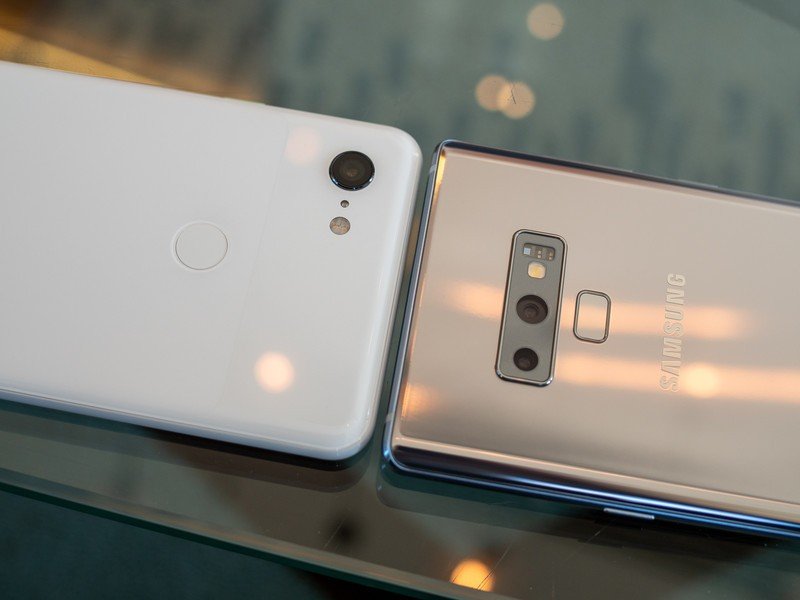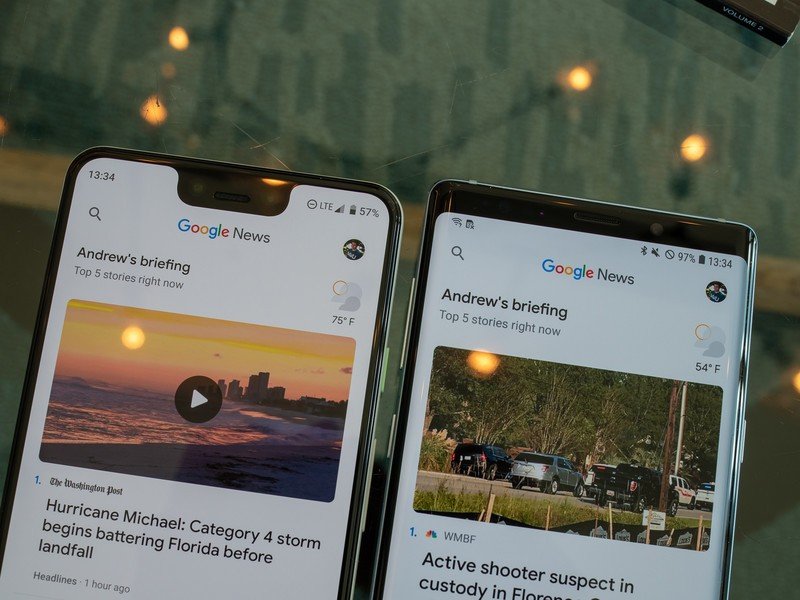Google Pixel 3 XL vs. Samsung Galaxy Note 9: Which should you buy?

Google Pixel 3 XL

Google improved its hardware and jumped to a 6.3-inch 18.5:9 display. It's not just about size though since the display is dramatically better as well. The rest of the phone builds on all of Google's strengths: simple hardware, capable specs, smooth software, and an amazing camera experience front and back. It also added wireless charging and kept stereo speakers.
Google Pixel 3 XL
Pure Google
Samsung Galaxy Note 9

This is Samsung's absolute top-of-the-line phone, and it shows. It has a best-in-class display, top-end specs across the board and loads of hardware features. The cameras are great, too, and the S Pen is truly unique. You just have to take the time to configure and tame Samsung's software.
Samsung Galaxy Note 9
Mighty S Pen
Though they're both high-end phones that command an equally high price, Google and Samsung have entirely different philosophies about what makes a great phone, so a lot of it comes down to personal preference. We compare the two in detail below.
What's the difference between the Google Pixel 3 and Samsung Galaxy Note 9?
With a handful of improvements this year, Google's Pixel 3 XL is more of a competitor to the Galaxy Note 9 than the 2 XL was to the Note 8. The Pixel 3 XL's screen is almost as big as the Note 9 and almost as good — it's indistinguishable in all respects except total brightness. Google has added wireless charging, a staple Samsung feature, and is IP68 water- and dust-resistant, just like the Note 9. They run on the same Snapdragon 845 processor and have all of the same supporting radios and chips elsewhere inside.
These are flagship phones through and through — but in terms of raw specs, Samsung has a slight advantage.
But still, Samsung wins in the spec battle in a few ways. The Note 9 has 6 or 8GB of RAM to the Pixel's 4GB, giving it more runway for performance with taxing apps in the future. Its 128 or 512GB of storage also beats the Pixel's 64 or 128GB, and Samsung still offers a microSD card slot. The Note has a regular 3.5 mm headphone jack, which is still preferable to using Google's in-box USB-C headphones — and the Pixel's better stereo speakers don't make up the difference. The Note 9's 4000mAh battery is a clear winner over the Pixel 3 XL's 3430mAh, both in capacity and overall battery longevity.







Design-wise, these phones are very similar — they're panes of glass sandwiching metal frames. There are just two main differences here: the Pixel 3 XL is smaller and lighter, while the Note 9 has a curved screen on the sides that some people find it tough to handle. Being smaller and lighter is certainly a win every time, but whether the Note 9's curved sides bother you will be something you have to experience for yourself.
| Category | Pixel 3 XL | Note 9 |
|---|---|---|
| Operating system | Android 9 Pie | Android 8.1 Oreo |
| Display | 6.3-inch OLED2960x1440 (18.5:9)Gorilla Glass 5 | 6.4-inch Super AMOLED2960x1440 (18.5:9)Gorilla Glass 5 |
| Processor | Qualcomm Snapdragon 845Pixel Visual Core | Qualcomm Snapdragon 845 |
| RAM | 4GB | 6/8GB |
| Storage | 64/128GB | 128/512GB |
| Expandable | No | microSD |
| Rear camera 1 | 12.2MP, 1.4-micronf/1.8, OIS, PDAF | 12MP, 1.4-micronf/1.5 or f/2.4, OIS, PDAF |
| Rear camera 2 | n/a | 12MPf/2.4, OIS, telephoto lens |
| Front camera 1 | 8MP, f/1.8, auto focus75-degree lens | 8MP, f/1.7, auto focus |
| Front camera 2 | 8MP, f/2.2, fixed focus97-degree lens | n/a |
| Connectivity | Wi-Fi 802.11ac 2x2 MIMO, Bluetooth 5.0 LE, NFC, GPS | Wi-Fi 802.11ac 2x2 MIMO, Bluetooth 5.0 LE, NFC, GPS |
| Audio | Stereo speakersUSB-C | Stereo speakers3.5 mm headphone jack |
| Battery | 3430mAhNon-removable | 4000mAhNon-removable |
| Charging | 18W USB-C PDQi wireless | Quick Charge 2.0Qi wireless |
| Water resistance | IP68 | IP68 |
| Security | Fingerprint sensor | Fingerprint sensorIris scanning |
| Dimensions | 158 x 76.7 x 7.9 mm184 g | 161.9 x 76.4 x 8.8 mm201g |
| Colors | Just Black, Very White, Not Pink | Midnight Black, Ocean Blue, Cloud Silver, Lavender Purple |
The bigger differences between the phones are more nuanced ones: camera performance and software experience.
Be an expert in 5 minutes
Get the latest news from Android Central, your trusted companion in the world of Android
Right off the top, I'll recognize that both phones have fantastic cameras and take really good photos. Any differences noted between the two are either small, minimally consequential, or simply a matter of preference. That being said, if I have to put my foot down on one I'll say the Pixel 3 XL takes better photos overall, the reason being that the Pixel consistently takes more eye-pleasing photos with more accuracy and more lifelike representation of scenes. The Note 9 is certainly capable of these kinds of shots, but tends more toward upping the colors unnaturally and overly smoothing details to an unrealistic level of sharpness. The photos look amazing, and you may even prefer them that way, which is why it's really tough to pick between these two.
These phones are matched in so many ways, but there's a clear divide in software and experience.
When it comes to portrait mode and zooming, things are about a wash even though the Note 9 has a second camera to work with. Google does amazing things with just one camera, making digital zoom and portrait mode look just as good as what Samsung does with a single lens. Where Google has an upper hand is in selfies, where its secondary camera provides an actual portrait mode for front-facing shots, as well as a wide-angle view, whereas Samsung sticks with a single camera — but in either case, you get great selfies with a high resolution and auto focus.
Now, software. It's no secret that Google goes with a simpler, cleaner approach than Samsung. You don't get as many features, but you definitely get an easier-to-understand software experience that's faster to pick up and figure out whether you're a novice or a pro. The features Google chooses to include are easy to "set and forget" so they're not getting in your way, and you don't feel like you're spending time in menus and settings to get the phone to just work. On the other hand, those are all things you have to tread through with the Note 9 — the upside, of course, is the customization angle, so you can get the exact experience you want. If you work at it, you can leverage the dozens of features to accomplish even more without installing apps. And that dovetails right into the discussion of the S Pen, which is something without equal on the Pixel side.
With either one of these phones, you get a high-end hardware experience with the latest specs and hardware features. You get a great camera, plenty of power, really nice design and so much more. The question is whether you want the extra bump in specs and features on the hardware side, and are willing to give up Google's preferable software experience to get it.

Google's best-ever phone
Phones are large nowadays, and Google's Pixel 3 XL is no exception. A 6.3-inch OLED screen is dramatically improved from the Pixel 2 XL, and the rest of the experience builds on Google's strengths: awesome software, great performance, innovative camera features, and guaranteed updates.

The do-everything flagship
Samsung's "more is better" approach is in full effect with the Note 9. It has a packed spec sheet, all of the hardware features you want, and tons of extra software to support it. Plus, it has an S Pen stylus and a huge battery. It just lacks some of the polish you get from Google's Pixel line.
Andrew was an Executive Editor, U.S. at Android Central between 2012 and 2020.

